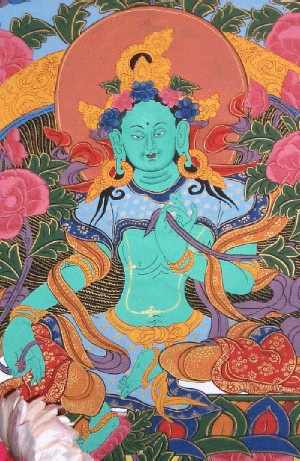
"I, O Lord,
shall lead [beings] across the great flood of their diverse fears;
Therefore the eminent
seers sing of
me in the world by the name of Tara."
The Hundred and Eight Names of the Venerable Tara spoken by the illustrious Lord Avalokita
"Compassionate
Saviouress from samsara! Goddess
born
From the tears of Him
with Lotus in Hand, by the power of the vow
Of Amitabha; most loving,
striving for others good, ...
Ven'rable One! I cannot
describe Your infinite virtues."
Nargarjuna
"Arya Tara who
symbolizes the activity of all the Buddhas ..."
His Holiness the Fourteenth Dalai Lama
"Stunned by beauty,
overwhelmed by grace, it was only through You that I experienced the fullness
of giving..."
Anonymous
![]()
![]()
![]()
![]()

Terhune, Lea. Karmapa
of Tibet: The Politics of Reincarnation. Wisdom Publications, 2004.
The Seventeeth Karmapa's daily life is a quiet one. Gyuto Monastery is located off the main drag of Sidhabari, a village situated on the green, fertile agricultural land below the Dauladar Range. In winter the mountains behind the monastery are dusted with snow. The monastery is build on land that rises toward the mountains. The Karmapa stays on the upper floor of the pale yellow residential wing behind the main audience hall. Yellow is a color traditionally associated with Buddhist monks. He takes his exercise on the roof. His disciplined daily life is confined to about 1,200 square feet. He rises early to pray and eat breakfast before spending a few hours with his tutors. His first puja of the day is to Green Tara, the female bodhisattva who brings good fortune and fulfillment.
There are moments
during life when a startling but marvellous experience leaps into mind as though
coming from another world. The magic that calls if forth--as though someone
had accidentally whispered the 'open sesame' that rolls the stone back from
the hidden treasure--is often so fleeting as to be forgotten in the joy of the
experience. It may be a thin cadence of music: a skylark bursting into song,
the splash of a wave, a flute played by moonlight. It may be a grand harmony
of sound, peaceful or awe-inspiring: the murmurous voices of a summer's afternoon
or the fateful shrieking and drumming of a mountain storm. It may be something
seen: a lovely smile or the curve of an arm; a single gesture, form or hue of
compelling beauty; a familiar scene transformed by an unusual quality of light;
a majestic panorama of interweaving colours splashed across sea or sky; a cluster
of rocks suggestive of enormous beings imbued with life. Or the spell may be
wrought by a sudden exaltation springing directly from the mind and jerking
it, so to speak, into an unknown dimension.
This page provides information for western students interested in the Tibetan Goddess Arya Tara, a meditation diety who may, if She chooses, jerk the student's mind into an unknown dimension. Links to current publications and background materials may be helpful to those interested in meditative practice.
Tara is the most beloved of deities, particularly for the Tibetans. Legend has it that once, as person just like us, she has served countless Buddhas. And ages ago she took the Bodhisattva Vow, to work for the benefit of all beings until every one of us is enlightened. While this page is dedicated to her Tibetan form, as Mother Goddess she arises out of many times and places--Durga and Tara in India or Demeter, Artemis, and Isis in Rome who were later overshadowed by the Virgin Mary. Tara is quite well known to the West through Her Tibetan manifestations, but some are unaware of the important position She occupies in the Hindu tantrik pantheon. She is the second of the ten Mahavidyas. Erich Neumann, a former student of Carl Jung, discusses the highest form of the feminine archetype, the Goddess of Spiritual Transformation, and views Tara as the highest evolution of this universal aspect of consciousness.
Radically defying the tradition of assuming only male rebirths after taking the Bodhisattva Vow, she made a second vow - to work for others forever in the form of a woman. At the turn of the second millennium, as the feminine archetype arises out of intense planetary need, Tara lives and works intimately in the world as a Bodhisattva. In contrast to most of the Buddhist Tutelary Dieties she is directly accessible to the uninitiated, a characteristic which contributes to her popularity. Her heart, devastated by the torture and killing of her disciples in Tibet, has followed the diaspora of Tibetan Lamas across the planet. As a result, she is very accessible to western students who practice her sadhana.
"Among the Buddha's many human and divine disciples, there were four great celestial or angelic Bodhisattvas, Enlightenment Heroes, who are believed to have taken a special interest in Tibet and the Tibetans. These are the female Boddhisattva Tara, Lady of Miraculous Activities, and the usually male Bodhisattvas Lokeshvara, Lord of Compassion, Manjushri, Lord of Wisdom, and Vajrapani, Lord of Power. These Boddhisattvas are only in one sense disciples of the Buddha; in another sense they are themselves already perfect Buddhas. They became perfect Buddhas innumerable world-eons before our universe and vowed to manifest as disciples of all Buddhas in all world systems in order to mediate between those Buddhas and the human populations of those worlds." (Thurman, 1995)
![]()
Atisha - "... like a king, the crown ornament of Indian Buddhists, [he] was regarded as a second Buddha." The founder of what is now the dominant form of Tibetan Buddhism brought Tara to Tibet at the turn of the first millennium.
Machig Labdron - "the Shining Light of Lab."
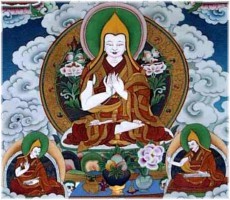 Tsongkapa
- "the Conqueror," teacher of the first Dalai Lama, and greatest of the
Tibetan philosophers.
Perhaps one of the greatest philosphers who has ever lived. "Until
you understand Wittgenstein, you can't understand Tsongkapa." (Thurman,
1991)
Tsongkapa
- "the Conqueror," teacher of the first Dalai Lama, and greatest of the
Tibetan philosophers.
Perhaps one of the greatest philosphers who has ever lived. "Until
you understand Wittgenstein, you can't understand Tsongkapa." (Thurman,
1991)
"Accordingly, all the disciples of Atisa and of the Conqueror Tsongkapa took the holy Tara as their highest deity, and prayed to her alone, especially the Omniscient Gedundrub (the first Dalai Lama) would do whatever he did only after he had prayed to the holy Tara, and thereby his active power to augment the aims of the teachings and of beings became as great as infinite space. Indeed, the majority of holy men in former times took the holy Tara as their highest deity..." Beyer, 1978, p. 14.
Goddess of the Underworld
Goddess of the Earth
Goddess of the Heavens
Complete and Perfect Buddha
Goddess of Action
![]()
The single face of the Chief Lady is the understanding of all events as a single knowledge. The green color of her body is power in all functions. Her two hands are the understanding of the two truths: her right hand the conventional truth, her left hand the absolute truth. Her right foot stretched out is the abandonment of all the defects of Mara; her left foot drawn back is the understanding of all qualities. Her adornment with all ornaments is the completion of the stocks of merit and knowledge.... Her right hand in the gift-bestowing gesture is the completion of the Perfection of Charity; her left hand in the protection gesture is the guarding of all beings from terror. Her holding the lotus flower is the giving of joy to all beings. Her being sixteen years of age is the ability to accomplish the aims of all beings. Her throne of the orb of the moon is the possession of Wisdom, and her throne of a varicolored lotus is the possession of an essence of Compassion. Nargarjuna (Beyer, 1978, pp. 80-81.)
Astamahabhayatara - 8 Taras
Varnished Tara - Tsa Tsa votive
Four Figures - Sakyamuni, Tsongkapa, Tara, and Sadaksari Avalokitesvara
Kurukulla - Red Tara
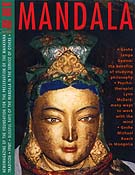 Queen
Wenchung, seventh-century queen of Tibet and an emanation of the Buddha
Tara, who brought to Tibet from China the famous Jowo Rinpoche, the statue of
Shakyamuni Buddha in the Jokhang Temple in Lhasa. Photo by Robin Bath, cover
of Mandala, Jul/Aug 1997.
Queen
Wenchung, seventh-century queen of Tibet and an emanation of the Buddha
Tara, who brought to Tibet from China the famous Jowo Rinpoche, the statue of
Shakyamuni Buddha in the Jokhang Temple in Lhasa. Photo by Robin Bath, cover
of Mandala, Jul/Aug 1997.
White tara
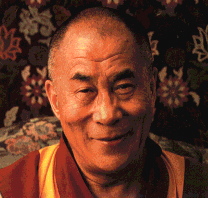 Tibet
in Exile
Tibet
in Exile  Blofeld, John. The
Tantric Mysticism of Tibet: A Practical Guide to the Theory, Purpose, and Techniques
of Tantric Meditation. Arkana (Penguin Books), 1970. ISBN: 0-14-019336-7.
Blofeld, John. The
Tantric Mysticism of Tibet: A Practical Guide to the Theory, Purpose, and Techniques
of Tantric Meditation. Arkana (Penguin Books), 1970. ISBN: 0-14-019336-7.
 Thurman, Robert A.F. Essential
Tibetan Buddhism. Harper 1995.
Thurman, Robert A.F. Essential
Tibetan Buddhism. Harper 1995.
Campbell, June. Traveller in Space: In Search of Female Identity in Tibetan Buddhism. George Braziller, 1996.
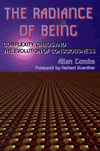 Combs,
Allen. The
Radiance of Being: Complexity, Chaos, and the Evolution of Consciousness.
Paragon House, 1996.
Combs,
Allen. The
Radiance of Being: Complexity, Chaos, and the Evolution of Consciousness.
Paragon House, 1996.
 Lopez,
Donald S. Prisoners
of Shangri-LA: Tibetan Buddhism and the West. University of Chicago Press,
1998.
Lopez,
Donald S. Prisoners
of Shangri-LA: Tibetan Buddhism and the West. University of Chicago Press,
1998.
Powers, John. Introduction to Tibetan Buddhism. Snow Lion Publications, 1995.
 Thurman,
Robert A. F. Inner
Revolution : Life, Liberty, and the Pursuit of Real Happiness. Riverhead
Books, 1998.
Thurman,
Robert A. F. Inner
Revolution : Life, Liberty, and the Pursuit of Real Happiness. Riverhead
Books, 1998.
 Surya
Das, Lama. Awakening
the Buddha Within: Tibetan Wisdom for the Western World. Bantam Books, 1997.
Surya
Das, Lama. Awakening
the Buddha Within: Tibetan Wisdom for the Western World. Bantam Books, 1997.
 Beyer,
Stephan. The
Cult of Tara: Magic and Ritual in Tibet. University of California Press,
1978. (classic text on Tibetan Tara rituals)
Beyer,
Stephan. The
Cult of Tara: Magic and Ritual in Tibet. University of California Press,
1978. (classic text on Tibetan Tara rituals)
Dharmachari Purna. Tara: Her Origins and Development. Western Buddist Review, Volume 2.
"Over my years of meditation on the goddess-Bodhisattva Tara, she has provided me with Refuge and, guiding star that she is, given me a direction by which to steer. I write this in the hope that others may also learn something of her friendly light."
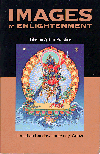 Landaw,
Jonathan and Weber, Andy. Images
of Enlightenment: Tibetan Art in Practice. Snow Lion Publications, 1997.
Landaw,
Jonathan and Weber, Andy. Images
of Enlightenment: Tibetan Art in Practice. Snow Lion Publications, 1997.
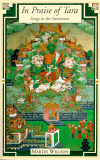 Willson,
Martin. In
Praise of Tara: Songs to the Saviouress, Revised Edition. Wisdom Publications,
1996.
Willson,
Martin. In
Praise of Tara: Songs to the Saviouress, Revised Edition. Wisdom Publications,
1996.
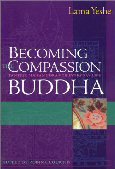
Yeshe, Lama Thubten. Becoming Compassion Buddha: Tantric Mahamudra for Everyday Life. Wisdom Publications, 2003.
Hopkins, Jeffrey. Meditation on Emptiness. Wisdom Publications, 1996. (Good preparation for Tsong Khapa's work.)
 Rinpoche,
Kalu. Luminous Mind: The Way of the Buddha. Wisdom
Publications, 1997.
Rinpoche,
Kalu. Luminous Mind: The Way of the Buddha. Wisdom
Publications, 1997.
Thurman, Robert. The Central Philosophy of Tibet : A Study and Translation of Jey Tsong Khapa's 'Essence of True Eloquence'. Princeton University Press, 1991.
Yeshe, Lama Thubten. The Bliss of Inner Fire : Heart Practice of the Six Yogas of Naropa. Wisdom Publications, 1998.
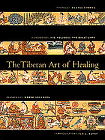 Baker,
Ian A. and Shrestha, Romio. The
Tibetan Art of Healing. Chronicle Books, 1997.
Baker,
Ian A. and Shrestha, Romio. The
Tibetan Art of Healing. Chronicle Books, 1997.
![]()

